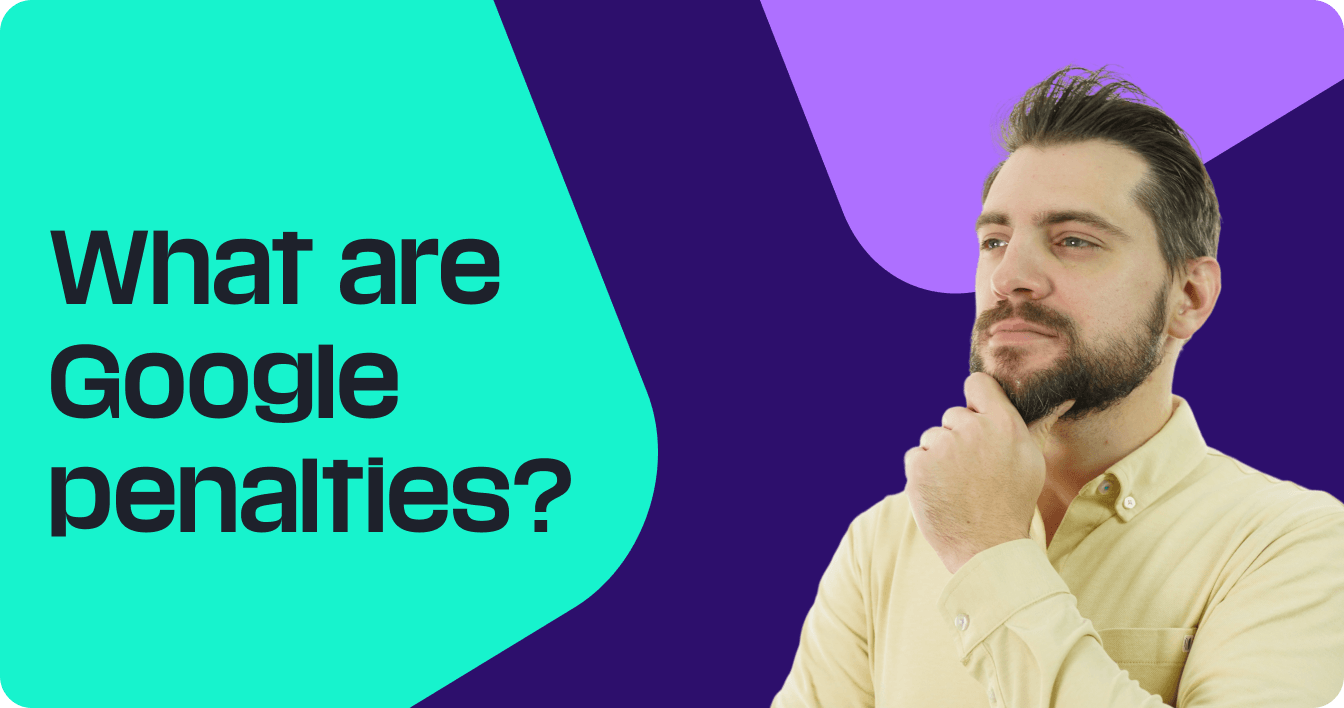If you’re reading this article, there’s a high chance that you’ve recently been “banned from Google.” It’s not a fun place to be in, and can often have a serious impact on your business. Luckily, there are several things you can do to reverse such a ban and return to Google’s good graces!
Let’s start by setting some expectations:
- Is there a quick solution? Not really. Reversing a Google ban isn’t an overnight process. It requires patience, persistence, and adherence to Google’s policies.
- There aren’t any magic tricks! This guide doesn’t offer any shortcuts or quick hacks because frankly, they don’t exist when it comes to Google bans.
That being said, every problem has a solution. It just requires the right knowledge and the right approach!
Get Your Website Back on Google with the SEO experts at WebFX
Our SEO experts can help diagnose the problem and create a tailored plan to restore your website’s rankings.

Understanding Google’s policies
Before we get too far into the process of how to remove a ban from Google, it’s important that we understand why these bans are imposed in the first place. To do so, we need to take a look at Google’s policies.
Why are Google’s policies important?
Google is committed to providing a secure, useful, and engaging experience for its users. To ensure this, Google’s established a robust set of guidelines and policies that govern how users and businesses interact with its services.
Violating these policies may result in penalties ranging from temporary restrictions to outright bans.
The main categories of Google’s policies
Google’s policies cover a broad spectrum but for the purpose of our discussion, let’s focus on two main categories:
- Webmaster Guidelines: These policies relate to your website and its content. They provide information about Google-friendly site designs, technical guidelines (use of robots.txt), quality guidelines (avoiding deceptive practices or content), etc.
- Advertising Policies: These rules apply if you’re using any of Google’s advertising products like AdWords or AdSense. They provide guidance on what types of ads are allowed or disallowed, how ads should be targeted and positioned, and so on.
Understanding these policies can help you pinpoint potential reasons for your ban and guide your efforts when working towards a reversal.
How to stay informed about policy updates
Google frequently updates its policies based on evolving user needs, technological advancements, legal requirements, and more. Staying updated can help you avoid potential pitfalls that might lead to a ban.
Here are some ways you can stay informed:
- Regularly visit Google’s Policy Center.
- Subscribe to Google’s official blogs.
- Participate in webmaster forums where policy changes are often discussed.
Remember, knowledge is power! The more you know about Google’s operating principles as defined by their policies, the better equipped you’ll be in navigating challenges such as removing a ban.
The top reasons for a Google ban
Now that we’ve established an understanding of Google’s policies, let’s explore some common reasons why Google might have imposed a ban on your website or account. In most cases, Google doesn’t take such drastic actions without reason.
Search violations (Non-approved SEO strategies)
Google aims to provide its users with the most relevant search results above all else.
To ensure fairness and relevance, Google has developed sophisticated algorithms responsible for its search results. Any attempt to manipulate these through non-approved SEO practices or SEO attacks (commonly known as Black-Hat SEO) can result in a ban.
Some examples include:
- Keyword Stuffing: Overloading your webpage with keywords in an unnatural way.
- Cloaking: Presenting different content or URLs to users and search engines.
- Link Schemes: Participating in schemes designed to increase your site’s ranking by manipulating the number of links pointing to your page.
P.S. While using AI for SEO is not a direct search violation, it can cause them indirectly.
Violation of ad policies
If you’re using Google’s advertising products like AdWords or AdSense, violating their ad policies can get you banned. Some common violations include:
- Misrepresentation: Misleading users about your business, product, or service.
- Prohibited Content: Promoting content that’s not allowed on Google like counterfeit goods, dangerous products or services etc.
- Invalid Click Activity: Generating artificial clicks or impressions on your Google ads.
Malware and hacking
Google takes user security very seriously. If your site is hacked, infected with malware, pushing phishing schemes, or responsible for any other form of harmful software, you can expect an immediate ban (even if it wasn’t your fault in the first place).
The next step is identifying the type of ban you’re dealing with, and going from there.
Identifying your ban
To get a Google ban removed, you first must identify what sort of ban you’re dealing with.
The approach to a Google ban appeal and remove a Google ban will vary based on the type of ban:
Search / Search engine results page (SERP) ban
A search ban means that your website is not appearing in Google’s search results at all. This usually happens when you violate Google’s Webmaster guidelines.
To confirm if your website has been removed from Google’s index, try this simple search:
- Site:yourwebsite.com
Replace “yourwebsite.Com” with your actual domain name. If you see no results, this can indicate that your site has been entirely deindexed and banned from appearing in Google’s search results.
These “bans” are typically algorithmic in nature, meaning something you did caught the attention of one of Google’s many algorithms meant to prevent search result manipulation.
AdSense or AdWords ban
If you can’t run ads using Google AdWords or can’t display ads using Google AdSense, you’re likely facing an advertising ban. Such bans are usually due to violations of Google’s Advertising Policies.
You can check the status of your account in the respective platform’s dashboard (AdWords or AdSense). If banned, you’ll see a notification explaining the violation and suspension details.
Manual Action by Google’s Webspam team
Sometimes Google’s Webspam team may manually penalize a website for violating its guidelines. This is different from algorithmic penalties, which are automated based on Google’s algorithms. The two can look very similar at first glance.
You can verify a Manual Action by checking for any notifications in your Google Search Console under the ‘Security & Manual Actions’ > ‘Manual Actions’ section.
Steps to appeal a Google ban
Now that we’ve identified the type of ban, it’s time to start working on getting it removed. Remember, patience and persistence are key here. Google receives countless appeals every day, so the process might take some time.
Appealing a search ban
If your website has been deindexed from Google’s search results, follow these steps:
- Identify and address violations: Review Google’s Webmaster Guidelines carefully and identify where your site might have violated them. Check your Search Console account for any notifications or warnings that may explain the loss of search visibility. Once identified, fix those issues.
- Submit a reconsideration request: After rectifying the issues, submit a reconsideration request via Google Search Console. Explain what happened, how you fixed it, and what measures you’ve taken to prevent future violations.
Appealing an AdWords or AdSense ban
For advertising bans, the process is slightly different:
- Identify policy violations: Check your email or notification in AdWords/AdSense dashboard for details about the policy violation.
- Rectify the issue: Make necessary changes to your ads, landing pages or website content as per policy guidelines.
- Appeal process: Submit a Google ban appeal through Google’s Help Center (AdWords Help for AdWords bans and AdSense Help for AdSense bans). Be transparent about the issue and how you’ve addressed it.
Appealing a Manual Action
If you received a manual penalty from Google’s Webspam team:
- Review manual action report: In your Google Search Console account, review the manual action report for details about the violation.
- Fix violations: Address all highlighted issues appropriately.
- Submit a reconsideration request: Like with algorithmic search bans, submit a reconsideration request explaining how you’ve addressed the issues.
Take note that each appeal process requires absolute transparency from your end about what went wrong and how you’ve corrected it.
Best practices to avoid future bans
After appealing a Google ban, it’s time to focus on ensuring you don’t find yourself in the same predicament again.
Here are some best practices to follow in the name of avoiding future bans:
Stick to ethical SEO practices
Adhere strictly to White-hat SEO techniques as outlined in Google’s Webmaster Guidelines. These include:
- Creating high-quality, original content
- Using relevant, well-researched keywords
- Building natural backlinks
- Regularly updating your website with fresh content
Comply with Ad policies
If you’re using AdWords or AdSense, always stay updated with and adhere to Google’s Advertising Policies. Key actions include:
- Being transparent about your business, product, or service
- Avoiding promotion of prohibited content
- Ensuring valid click activity
Maintain your website’s security
Keep your website safe from hackers and malware. This not only helps avoid a Google ban but also protects your visitors’ information. Some general website security tips include:
- Regular updates of software and plugins
- Using secure hosting services
- Implementing SSL for a secure connection
- Regular backups of your website
Monitor your website’s performance
Regular monitoring can help detect potential issues before they escalate into bigger problems leading to a ban:
- Use tools like Google Search Console and Google Analytics for insights into your site’s performance and potential issues.
- Regularly check for crawl errors, broken links, or sudden drops in traffic or search rankings.
Remember, prevention is always better than cure. By following established best practices, you can minimize the risk of facing another Google ban and maintain a healthy online presence.
Staying ban-free
The biggest takeaway from dealing with a Google ban should be that proactively avoiding a ban is always better than spending time, effort, and money to get one reversed.
Adhering strictly to Google’s guidelines, maintaining website security, monitoring your site’s performance regularly, and staying updated with SEO and ad policy changes can go a long way in preventing future bans.
Facing a Google ban can be intimidating, but remember that it’s not the end of the world. With patience, transparency, and persistence, you can get your online presence back on track!
Reclaim Your SEO and Future-Proof Your Strategy
Partner with the #1 rated agency in the United States (via Clutch) for ethical SEO practices that ensure long-term success and consistent results.
Need Expert Help Recovering?
Let our SEO specialists analyze your site and create a custom recovery plan to get you back in Google’s good graces.
Need Expert Help Recovering?
Let our SEO specialists analyze your site and create a custom recovery plan to get you back in Google’s good graces.
What to read next
- Jan 06, 2026
- 5 min. read
- Dec 24, 2025
- 8 min. read
- Dec 22, 2025
- 9 min. read




